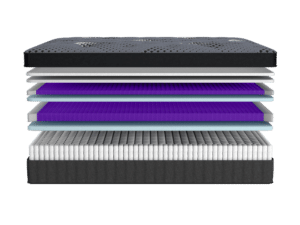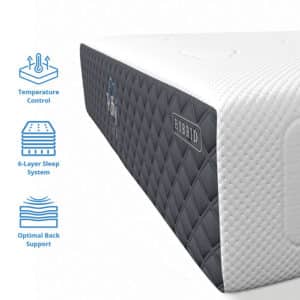You spend nearly a third of your life in bed; therefore your mattress plays an essential part in your everyday life. A supportive and comfortable mattress is crucial for your body to get the rest and recovery it needs each night.
Your mattress may not be the first thing that comes to mind when you are not sleeping well, but it is often the culprit and a sign it is time to invest in a new mattress.
Waking up sore, having trouble sleeping, sleeping too hot, signs of wear-and-tear (sagging, lumps or body impressions), increased allergies or asthma, and the age of your mattress are all signs of when to get a new mattress.
A Mattress Lifespan
Fortunately, mattresses have a reasonably long lifespan. While there is no firm rule for when to replace your bed, the average mattress usually lasts about 10 years – that is 3,650 nights of sleep! Factors like your sleep position, weight, and whether you share a bed all play a part in how long a mattress lasts.
Even if your mattress is not showing any of the signs of age, if it is close to 10 years old or older, you may want to look into purchasing a new bed.
Mattress Materials

The quality of your mattress has an impact on how long it lasts. While a higher price tag does not necessarily mean a better product, the material your mattress is made of and the quality of the construction have a direct effect on its longevity.
Materials like latex, high-density memory foam and high-density polyfoam can last a long time, while low-density memory foam and low-density polyfoam can wear out more quickly. While natural latex mattresses and Smart Beds tend to last the longest, luxury memory foam mattresses, hybrid mattresses and luxury innerspring mattresses also have a longer life than beds made from low-grade memory foam or poly foam and traditional innerspring beds.
Memory Foam
A memory foam mattress made with high-density memory foam effectively molds to the heat and pressure of your body in minutes then returns to its original shape as soon as you move to another position or get out of bed.
A low-density memory foam may have a slower recovery time and body impressions may become permanent after just a few years. As the cellular structure of the memory foam breaks down it will become softer and less resilient, therefore not supporting your body as it should.
Body impressions over two inches deep are a sign that it is time to replace your mattress.
Be sure to avoid extremely inexpensive memory foam mattresses that tend to seem too good to be true.
You do want to rotate your memory foam mattress regularly, keep it clean, and set it on a supportive base to get the longest lifespan possible.
At Mattress Express, check out our Puffy line.
Latex
Natural latex is the most resilient mattress material, which means that latex mattresses are the longest-lasting.
Natural latex mattresses often cost more but tend to double the lifetime of other mattresses.
Natural latex is a hypoallergenic material so if you or your partner suffers from allergies, a latex mattress maybe a necessary choice.
There are synthetic latex mattresses, blended synthetic, and natural latex mattresses available on the market but they have shorter lifespans. Look for the terms “Dunlop” or “Talalay” to ensure you are getting a natural latex bed.
You can rotate your natural latex mattress but it is not as necessary as other mattresses. Keeping your mattress clean and ensuring your mattress is on a supportive base will help you get the longest lifespan possible out of your latex mattress.
At Mattress Express, check out our Posh and Lavish Natural Latex Collection.
Take our Express Comfort Quiz for instant recommendations.Not sure which mattress is right for you?
Hybrid

Hybrid mattresses should be rotated regularly, kept clean and used on a supportive base to ensure the longevity of your mattress.
At Mattress Express, our Posh and Lavish Hybrid Collection and Purple Premier Hybrid line and Puffy Royal are just a few options we offer.
Inner Spring
Innerspring mattresses are made from a core of metal coil springs and vary from a thin or an abundant comfort layer depending on the quality and comfort level of each mattress. Luxury innerspring mattresses contain a pocketed coil core while traditional innerspring mattresses do not.
The coil springs provide the support in the bottom core of the mattress, while the amount and quality of the layers in the comfort core give you the comfort level of the mattress. The thickness of each core as well as the materials used have a huge impact on the lifespan of an innerspring mattress.
Traditional innerspring mattresses are still popular due to their inexpensive price tags, but may last only 5 years or less.
Weight of the Sleeper
If you are lighter weight, you may find your mattress or even just your side of your mattress keeps its shape longer than someone who is heavier. This is most noticeable when your partner’s weight is different from yours.
If you have a heavier build, you may prefer a mattress made with stronger materials like a hybrid style over a plush memory foam or low-end innerspring mattress.
Your sleeping position can also affect the longevity of your mattress, regardless of your weight. As a side sleeper, you will want a mattress that gives a little in the hip and shoulder areas. If you are a back or stomach sleeper, you will need more support in the hip area to avoid sagging too quickly and throwing your spine out of proper alignment.
Maintenance
Take good care of your mattress and it will last longer. The first step to take is to follow the manufacturer’s care guidelines.
Use a mattress protector at all times to safeguard your bed from stains, spills, sweat, mildew and bacteria. Regularly changing your sheets and protective cover will help keep dust mites, allergens and hair from going deep into your mattress. Vacuum your mattress with the upholstery attachment of your vacuum cleaner a few times a year to help avoid any accumulation that has occurred.
Rotate your mattress 180 degrees every few months to prevent wear and sagging from happening too soon. Mattresses will develop body impressions and indentations over time and is a sign it is time for a new mattress. Rotating your mattress regularly will help increase its longevity.
Signs Your Mattress is Wearing Out
Sleep is a time for your body to recover from the stresses it experiences during the day. If you can not fall asleep or have trouble staying asleep, your body will let you know.
Pain

If you are rolling out of bed every morning with aches and pains, it may also be a sign that you or your partner is frequently changing sleeping positions. Nevertheless, it may be another sign that your mattress is no longer a right fit and it is time for a replacement.
Allergens
If your allergies have gotten worse and it is not allergy season, it could be your mattress. Mattresses have been proven to carry one of the highest concentrations of dust mites, which cause respiratory problems that trigger allergies and asthma. If you or anyone in your house is experiencing allergic reactions, you may want to consider getting a new mattress.
Even if you wash your linens frequently, use a mattress protector and clean your mattress and pillows regularly. You will still get a buildup of dead skin cells, body oils, fluids, dust mites, mildew, fungal spores, pollen, and other allergens in your mattress. Mold and mildew are also common irritants found in mattresses that will trigger an allergic reaction.
If you notice yourself sneezing in bed or feeling stuffed up in the morning, it is probably time to replace your mattress.
Trouble Sleeping
If you are unable to fall asleep, wake up frequently during the night, or just adjust positions often, there is a good chance your mattress no longer gives you proper comfort. It is time to replace your mattress.
If you normally do not have a problem with temperature regulation but suddenly are sleeping hot, chances are your mattress is restricting airflow on the surface. You should look into getting a new mattress.
Physical Signs
Sagging is one of the most visible indications that a mattress needs to be replaced. Sagging can be a result of the breakdown over time of an innerspring core, compression of memory foam layers, or other materials found in the core of your bed.
If you notice even minor sagging and are waking up with aches and pains, it is a sign that your bed is no longer providing the proper support that your body needs.
Lumps or ruts in your mattress are a result of the padding within your mattress shifting around over time. This is a very common issue with pillow-top style mattresses that gained popularity in the late 90s and have become notorious for that reason. The uneven density means your body is not being supported adequately. Although lumps and ruts are more common with lower-quality mattresses, it can also happen with higher-end mattresses that have met the end of their lifespan.
Body impressions that are more than 2 inches deep and remain after you or partner get out of bed are most common in lower-quality memory foam mattresses but will occur in higher-end mattresses that are close to 10 years or older. Body impressions are another sign that your mattress is no longer supporting your body as well as when it was newly purchased.
Benefits of Replacing Your Mattress
Even if you have slept on the same kind of bed for many years, as your body ages, your mattress may need to change too.
When you get older, your body needs more support or comfort for you to be able to sleep soundly each night.
It also may be time for a new mattress if you sustained an injury, lost or gained a significant amount of weight, or have a new bed partner. If your mattress is still in the prime of its life but you’re not getting the support you need anymore, do not feel guilty about replacing it.
A new mattress will not only help you sleep better but it will increase your comfort, relieve back pain and stiffness, reduce stress, and improve your mood throughout your day. A good night of sleep will give you newfound energy you may have been missing.
A good night of sleep as a result of your new mattress has been linked to many health benefits, including a boosted immune system, reduced allergy symptoms, improved memory, sharpened focus, elevated moods as well as healthy weight loss if needed.
Conclusion
There are a lot of factors that go into buying a mattress and the brand you choose, but the top thing you should be concerned about is quality. You want to get better quality sleep, feel more comfortable, and know your mattress is made to last.
Check us out at mattressexpressny.com to research your options and then visit your Mattress Express location of choice so one of our sleep specialists can advise you further.

